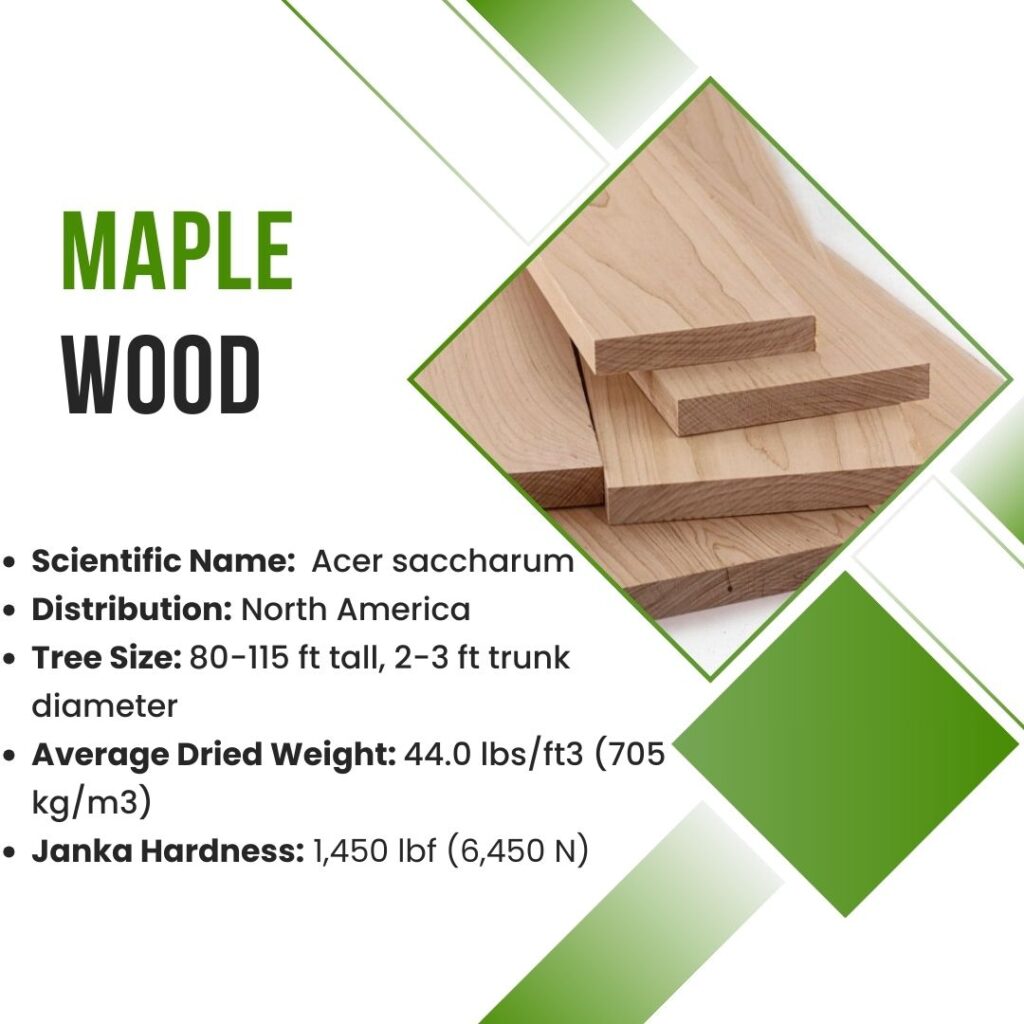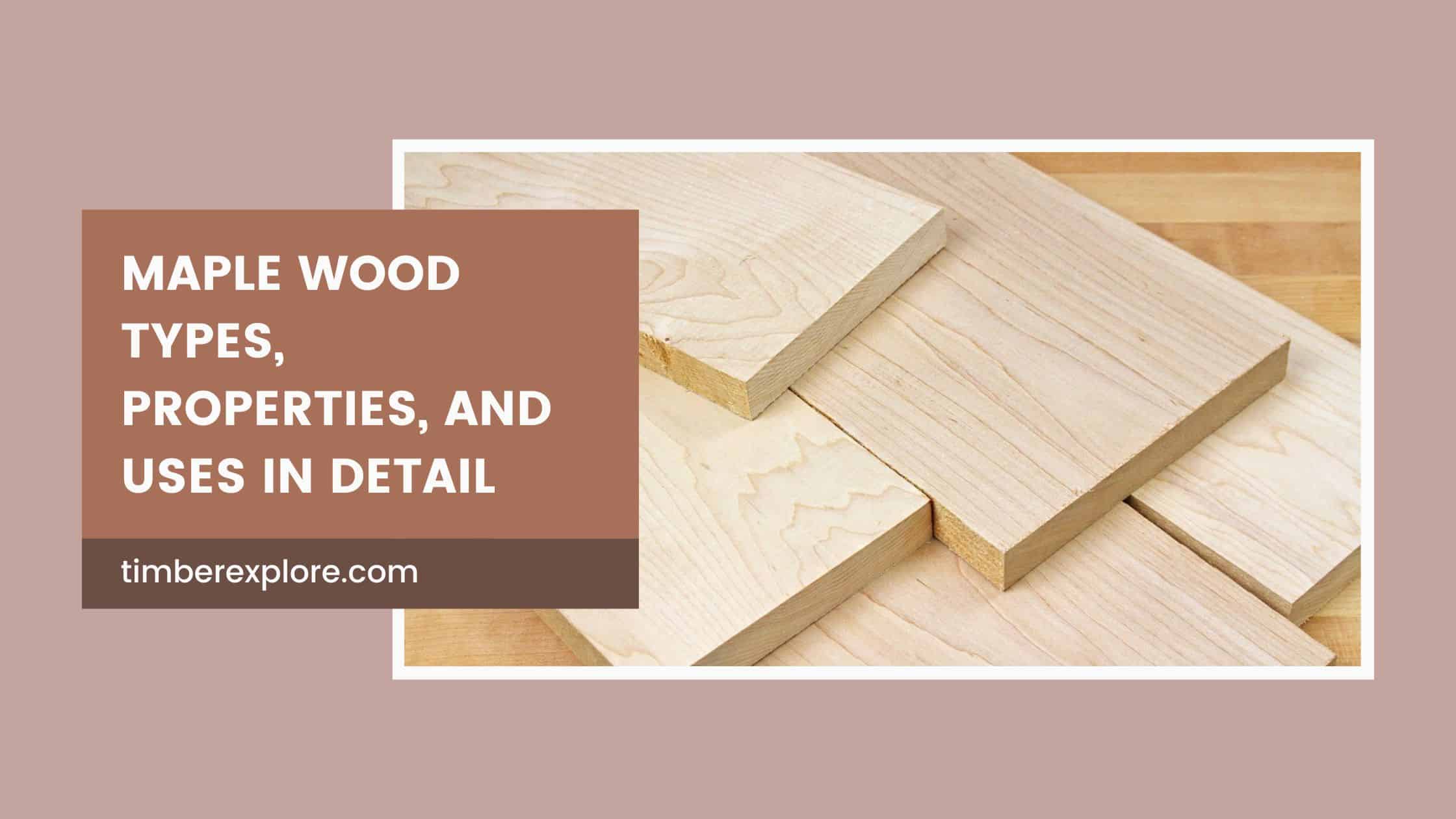It is a strong and attractive hardwood, also a favorite choice for a wide range of applications, from furniture making to flooring, musical instruments, and more. Prized for its durability and affordability, maple wood is favored by woodworkers and merchants alike for its impressive looks and strength. Here’s everything you need to know about maple wood properties, types, and uses.
What is Maple Wood?
It is sourced from trees, identifiable by their distinctly shaped, palmately lobed leaves. There are many species of maple trees, but hard, or sugar maple, is the most popular for woodworking. Interestingly, the same trees that produce hard maple are also tapped to obtain maple syrup.
The trees grow abundantly throughout Canada and Northeastern North America, making maple wood easily accessible and moderately priced.
Types of Maple Wood
It can be broadly categorized into two main types: hard and soft maple. Here, we delve into the specifics of each type and some unique varieties within these categories.
A. Hard Maple
Hard or sugar maple (Acer saccharum), is renowned for its hardness and density. Often referred to as rock maple, this wood is sourced primarily from the Northeastern United States and Canada. Hard maple trees typically grow to heights of 80-115 feet with trunk diameters of 2-3 feet.
- Hardness and Density: With a Janka hardness rating of 1,450 lbf (6,450 N) and an average dried weight of 44.0 lbs/ft³ (705 kg/m³), hard maple is incredibly strong and durable.
- Color and Grain: The sapwood is nearly white to off-white, sometimes with a reddish hue, while the heartwood is darker and less commonly used. The grain is generally straight but can exhibit unique patterns like curly, quilted, or birdseye.
- Uses: It is ideal for flooring, high-quality furniture, cutting boards, and sports equipment.
B. Soft Maple
It refers to a group of maple species that are generally softer than hard maple, although they are still relatively hard compared to other hardwoods. Common species include red (Acer rubrum), silver (Acer saccharinum), and bigleaf maple (Acer macrophyllum).
- Hardness and Density: Soft maple’s Janka hardness rating ranges from 700 to 950 lbf (4,230 N) with an average dried weight of 30.2 to 38.0 lbs/ft³ (485 to 610 kg/m³).
- Color and Grain: Similar in appearance to hard maple but often with a wider range of grain patterns. It is easier to work with due to its lower density.
- Uses: Frequently used for furniture, millwork, and musical instruments where intricate work is required.
Exploring 10 Unique Types of Maple Wood
1. Curly Maple
A variety of hard maple that is highly prized for its striking grain pattern that appears wavy or curly, creating a three-dimensional effect. Known also as tiger, flame, or fiddleback maple, this wood is commonly used in high-end furniture, musical instruments, and decorative woodwork.
2. Silver Maple
Native to North America, is a fast-growing tree with soft, lightweight wood. It is often used for inexpensive furniture, flooring, and carving. Though not as durable as other maples, its ease of work makes it popular for detailed woodworking projects.
3. Bigleaf Maple
Found in the Pacific Northwest, is known for its large leaves and unique figures in the wood, including quilted or curly patterns. It is commonly used for furniture, cabinetry, and musical instruments due to its bright and clear tone.
4. Black Maple
Native to the eastern regions of North America, produces wood that is hard, dense, and strong. It is used for flooring, furniture, and cabinetry, valued for its strength and fine, uniform texture.
5. Birdseye Maple
It features small swirling patterns that resembles a bird’s eyes. This wood is difficult to work with due to its irregular grain but is highly valued for its beauty and rarity, often used in high-end furniture and musical instruments.
6. Quilted Maple
It is recognized for its intricate, quilt-like grain pattern. This variety of hard maple is used in high-end furniture and musical instruments. Despite its hardness and the difficulty in working with its irregular grain, its unique appearance makes it highly sought after.
7. Striped Maple
It is also known as moosewood, is lighter and less durable than other maples. It is primarily used for decorative items like walking sticks and handcrafted objects due to its attractive striped bark.
8. Field Maple
Popularly known as hedge maple, is native to Europe and produces hard, dense wood used for furniture, flooring, cabinetry, and musical instruments.
9. Norway Maple
Native to Europe and western Asia, produces strong, dense wood used for a variety of applications including furniture and flooring.
10. Red Maple
Found in the eastern regions of North America, produces moderately hardwood used for furniture, flooring, cabinetry, and musical instruments. Its ornamental qualities are also highly valued.
Characteristics of Maple Wood

Properties of Maple Wood
Color
The sapwood ranges from nearly white to off-white, sometimes with a reddish hue, while the heartwood is darker and more fragile. The wood often displays unique patterns like quilted, curly, or birdseye, adding to its visual appeal.
Grain and Texture
It typically has a straight grain with a fine, uniform texture, making it easy to work with. Unique grain patterns such as birdseye, curly, and quilted are highly prized.
Hardness and Durability
It is a hardwood, with hard maple being significantly harder than soft maple. It has a Janka hardness rating of 1,450 lbf, making it one of the hardest domestic hardwoods. The wood is durable, resistant to shock, and suitable for heavy-duty applications, though it is not naturally resistant to moisture and decay.
Workability
It is generally easy to work with due to its straight grain. However, hard maple’s high density can make cutting challenging, and it may burn when cut with high-speed tools. Maple finishes turns, and glues well, though staining can be tricky without a pre-conditioner.
Availability and Cost
It is widely available in North America and exported globally. Hard maple is more expensive due to its demand and superior properties, while soft maple is more affordable but still shares many characteristics with hard maple.
Uses of Maple Wood
- Flooring: Its hardness and durability make it an excellent choice for flooring in residential homes, basketball courts, and bowling alleys.
- Furniture: It is extensively used in furniture making, from dining tables and chairs to bed frames and dressers. Its fine grain allows for detailed craftsmanship.
- Cabinets and Millwork: The stability and aesthetic appeal make it ideal for cabinetry, trim, and moldings. It provides a sleek, polished finish that complements various interior styles.
- Musical Instruments: Its tonal qualities make it a preferred wood for musical instruments, including guitars, violins, and drums. Its resonance and bright tone enhance the sound quality.
- Kitchen Tools and Sports Equipment: Maple’s density and resistance to knife marks make it perfect for cutting boards and butcher blocks. It is also used for sports equipment like baseball bats and bowling pins.
- Decorative Items: The unique grain patterns make it popular for decorative items such as turned objects, veneers, and handcrafted items.

